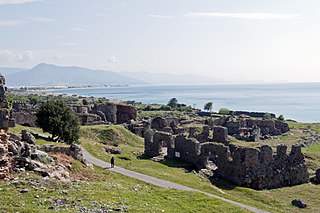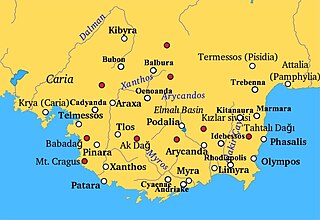Related Research Articles

Antiochia ad Cragum also known as Antiochetta or Latin: Antiochia Parva is an ancient Hellenistic city on Mount Cragus overlooking the Mediterranean coast, in the region of Cilicia, in Anatolia. In modern-day Turkey the site is encompassed in the village of Güneyköy, District of Gazipaşa, Antalya Province.
Antioch on the Maeander or Antiochia on the Maeander, earlier Pythopolis, was a city of ancient Caria, in Anatolia. The city was situated between the Maeander and Orsinus rivers near their confluence. Though it was the site of a bridge over the Maeander, it had "little or no individual history". The scanty ruins are located on a hill a few km southeast of Kuyucak, Aydın Province, Turkey, near the modern city of Başaran, or the village of Aliağaçiftliği. The city already existed when Antiochus I enlarged and renamed it. It was home to the sophist Diotrephes.

Anemurium, also called Animurium, is an ancient city whose ruins, now called Eski Anamur or Anemuryum, are close to the modern Turkish city of Anamur. It was in the Roman province of Cilicia, later Isauria, and was situated near a high promontory that marks the southernmost point of Asia Minor, only 64 km from Cyprus. In the Middle Ages, it was called Stallimur.
Dometiopolis was a city of Cilicia Trachea, and in the later Roman province of Isauria in Asia Minor. Its ruins are found in the village of Katranlı, Ermenek, Karaman Province, Turkey.
Harpasa was a city and bishopric in ancient Caria in Roman Asia Minor, which only remains a Latin Catholic titular see.
Sidyma, was a town of ancient Lycia, at what is now the small village of Dudurga Asari in Muğla Province, Turkey. It lies on the southern slope of Mount Cragus, to the north-west of the mouth of the Xanthus.
Titiopolis or Titioupolis was a town of ancient Cilicia and later in the Roman province of Isauria.
Arabissus or Arabissos, also known as Tripotamos, was a town in ancient Cataonia, then Cappadocia, and later in the Roman province of Armenia Secunda. The Byzantine Emperor Maurice was born there in 539. A cave of the Seven Sleepers is located in the Eshab-ı Kehf Kulliye.
Basilinopolis or Basilinoupolis was a town in Bithynia Prima, which obtained the rank of a city under, or perhaps shortly before, Roman Emperor Julian the Apostate, whose mother was Basilina.

Citharizum was a town and fortress on the south arm of the Euphrates in the Roman province of Armenia III. It was a place of great strength which was built by the emperor Justinian and was the residence of one of the five prefects whom that emperor placed over Roman Armenia with the title of “Dux.”
Cestrus was a city in the Roman province of Isauria, in Asia Minor. Its placing within Isauria is given by Hierocles, Georgius Cyprius, and Parthey's. While recognizing what the ancient sources said, Le Quien supposed that the town, whose site has not been identified, took its name from the River Cestros and was thus in Pamphylia. Following Lequien's hypothesis, the 19th-century annual publication Gerarchia cattolica identified the town with "Ak-Sou", which Sophrone Pétridès called an odd mistake, since this is the name of the River Cestros, not of a city.
Dalisandus or Dalisandos was a city of ancient Cappadocia and later of Isauria, near the river Cydnus. It is considered to have been near Sınabiç, 6 km north of Claudiopolis, Turkey.
Zenopolis was an ancient Roman and Byzantine city in Isauria. Its site is located near Elmayurdu in Asiatic Turkey.
Zenopolis was an ancient Roman and Byzantine city and episcopal see variously placed in Lycia or in neighbouring Pamphylia.

Podalia, also spelled Podalaea or Podalaia (Ποδαλαία), Podallia (Ποδαλλία), and Podaleia (Ποδάλεια), was a town of ancient Lycia, mentioned by several ancient authors.
Choma was a place in the interior of ancient Lycia, according to Pliny on a river Aedesa. Ptolemy places Choma as one of the four cities of the Milyas, and places it near Candyba. The town can be identified with a site near today's village of Hacımusalar in the district of Elmalı.
Carallia was a city of the Roman province of Pamphylia Prima and is mentioned in the acts of the Council of Ephesus (431). The same form of the name is given in the acts of the Council of Chalcedon (451).
Erymna or Orymna was a town in ancient Pamphylia or Lycia. The form "Orymna" is that given in the Synecdemus and the Notitiae Episcopatuum. and in the ecumenical councils, but inscriptions found on the site show that the inhabitants used the form with "E". Stephanus of Byzantium stated that the form used in the Lyciaca of Alexander Polyhistor was Erymnae. The modern name of the site is Ormana, reflecting the ancient name.
Sebela was an Ancient city and bishopric in Asia Minor and remains a Latin Catholic titular see.

Isinda was a town of ancient Pisidia.
References
- ↑ Richard Stillwell et al. (editors), The Princeton Encyclopedia of Classical Sites (Princeton University Press. 1976)
- ↑ The Princeton Encyclopedia of Classical Sites
- ↑ Michel Lequien, Oriens christianus in quatuor Patriarchatus digestus, Paris 1740, Tomus II, coll. 1017-1018]
- ↑ Mansi, Conc., VII, 563
- ↑ Titular Episcopal See of Charadrus
- ↑ Charadrus (Titular See)
- ↑ Lamus (Titular See)
- ↑ Titular Episcopal See of Lamus